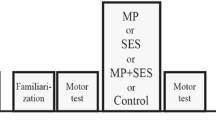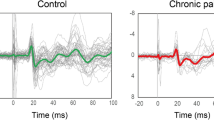Abstract
Recurrent subclinical neck pain (SCNP) may be associated with neural plastic changes in sensory processing and sensorimotor integration (SMI); however, its impact on motor learning has not been investigated. The aim of this study was to investigate whether SCNP alters neural markers of SMI during a complex motor acquisition task as compared to a healthy control group. Peripheral N9, spinal N13, brainstem N18, and cortical N20, P25, N24 and N30 early somatosensory evoked potentials (SEPs) were recorded following median nerve stimulation for 24 participants (12 control and 12 SCNP) before and after a 10-min tracing motor task intervention. Retention was assessed 24–48 h later. Significant amplitude differences were observed for both N18 and N24 SEP waveforms between groups, indicating there may be a difference in SMI due to altered afferent input as a result of SCNP. Accuracy increased significantly for both groups post-motor training; however, at retention only the control group showed an additional increase in accuracy. Both N18 and N24 SEP peaks are linked with cerebellar pathways, suggesting that SCNP impacts these connections. Significant correlations between these peaks and performance data were also seen. The differential changes in neurophysiological markers of SMI seen in SCNP suggest that SEPs have the potential to be used as an early screening tool for those at risk of having maladaptive neural plastic changes in response to motor training as a result of SCNP.






Similar content being viewed by others
References
Andrew D, Haavik H, Dancey E, Yielder P, Murphy B (2015a) Somatosensory evoked potentials show plastic changes following a novel motor training task with the thumb. J Clin Neurophysiol 126(3):575–580
Andrew D, Yielder P, Murphy B (2015b) Do pursuit movement tasks lead to differential changes in early somatosensory evoked potentials related to motor learning compared with typing tasks? J Neurophysiol 113(4):1156–1164
Baarbé J, Yielder P, Daligadu J, Behbahani H, Haavik H, Murphy B (2014) A novel protocol to investigate motor training-induced plasticity and sensorimotor integration in the cerebellum and motor cortex. J Neurophysiol 111(4):715–721
Bababekova Y, Rosenfield M, Hue JE, Huang RR (2011) Font size and viewing distance of handheld smart phones. Optom Vis Sci 88(7):795–797
Berolo S, Wells RP, Amick BC (2011) Musculoskeletal symptoms among mobile hand-held device users and their relationship to device use: a preliminary study in a Canadian university population. Appl Ergon 42(2):371–378
Byl N, Merzenich M, Cheung S, Bedenbaugh P, Nagarajan S, Jenkins W (1997) A primate model for studying focal dystonia and repetitive strain injury: effects on the primary somatosensory cortex. Phys Ther 77(3):269–284
Cheron G, Borenstein S (1987) Specific gating of the early somatosensory evoked potentials during active movement. Electroencephalogr Clin Neurophysiol 67:537–548
Cheron G, Borenstein S (1991) Gating of the early components of the frontal and parietal somatosensory evoked potentials in different sensory-motor interference modalities. Electroencephalogr Clin Neurophysiol 80:522–530
Daligadu J, Haavik H, Yielder P, Baarbé J, Murphy B (2013) Alterations in cortical and cerebellar motor processing in subclinical neck pain patients following spinal manipulation. J Manip Physiol Ther 36(8):527–537
Dancey E, Murphy B, Srbely J, Yielder P (2014) The effect of experimental pain on motor training performance and sensorimotor integration. Exp Brain Res 232(9):2879–2889
Dancey E, Murphy B, Andrew D, Yielder P (2016) The effect of local versus remote experimental pain on motor learning and sensorimotor integration using a complex typing task. Pain 157(8):1682–1695
Doyon J, Song AW, Karni A, Lalonde F, Adams MM, Ungerleider LG (2002) Experience-dependent changes in cerebellar contributions to motor sequence learning. Proc Natl Acad Sci 99:1017–1022
Doyon J, Penhune V, Ungerleider LG (2003) Distinct contribution of the cortico-striatal and cortico-cerebellar systems to motor skill learning. Neuropsychologia 41(3):252–262
Falla D, Bilenkij G, Jull G (2004) Patients with chronic neck pain demonstrate altered patterns of muscle activation during performance of a functional upper limb task. Spine 29(13):1436
Floyer-Lea A, Matthews PM (2005) Distinguishable brain activation networks for short-and long-term motor skill learning. J Neurophys 94(1):512–518
Fujii M, Yamada T, Aihara M, Kokubun Y, Noguchi Y, Matsubara M (1994) The effects of stimulus rates upon median, ulnar and radial nerve somatosensory evoked potentials. Electroencephalogr Clin Neurophysiol 92:518–526
Garcia Larrea L, Bastuji H, Mauguiere F (1992) Unmasking of cortical SEP components by changes in stimulus rate: a topographic study. Electroencephalogr Clin Neurophysiol 84:71–83
Gasbarri A, Pompili A, Pacitti C, Cicirata F (2003) Comparative effects of lesions to the ponto-cerebellar and olivo-cerebellar pathways on motor and spatial learning in the rat. Neuroscience 116:1131–1140
Ghilardi MF, Ghez C, Dhawan V, Moeller J, Mentis M, Nakamura T, Antonini A, Eidelberg D (2000) Patterns of regional brain activation associated with different forms of motor learning. Brain Res 871(1):127–145
Haavik H, Murphy B (2011) Subclinical neck pain and the effects of cervical manipulation on elbow joint position sense. J Manip Physiol Ther 34(2):88–97
Haavik H, Murphy B (2012) The role of spinal manipulation in addressing disordered sensorimotor integration and altered motor control. J Electromyogr Kinesiol 22(5):768–776
Haavik H, Murphy BA (2013) Selective changes in cerebellar-cortical processing following motor training. Exp Brain Res 231(4):397–403
Haavik Taylor H, Murphy B (2007a) Altered cortical integration of dual somatosensory input following the cessation of a 20 min period of repetitive muscle activity. Exp Brain Res 178(4):488–498
Haavik Taylor H, Murphy B (2007b) Cervical spine manipulation alters sensorimotor integration: a somatosensory evoked potential study. Clin Neurophysiol 118(2):391–402
Haavik-Taylor H, Murphy B (2007c) Transient modulation of intracortical inhibition following spinal manipulation. Chiropr J Aust 37(3):106
Haavik Taylor H, Murphy B (2011) Subclinical neck pain and the effects of cervical manipulation on elbow joint position sense. J Manip Physiol Ther 34:88–97
Hogri R, Segalis E, Mintz M (2014) Cerebellar inhibitory output shapes the temporal dynamics of its somatosensory inferior olivary input. Cerebellum 13(4):452–461
Kim MS (2015) Influence of neck pain on cervical movement in the sagittal plane during smartphone use. J Phys Ther Sci 27(1):15–17
Kristjansson E, Dall-Alba P, Jull G (2003) A study of five cervicocephalic relocation tests in three different subject groups. Clin Rehabil 17(7):768–774
Lederhendler I, Alkon DL (1986) Implicating causal relations between cellular function and learning behavior. Behav Neurosci 100:833–838
Lee H, Nicholson LL, Adams RD (2004) Cervical range of motion associations with subclinical neck pain. Spine 29(1):33–40
Lee H, Nicholson LL, Adams RD, Bae SS (2005) Proprioception and rotation range sensitization associated with subclinical neck pain. Spine 30(3):E60–E67
Lee HY, Wang JD, Yao G, Wang SF (2008) Association between cervicocephalic kinesthetic sensibility and frequency of subclinical neck pain. Manual Ther 13(5):419–425
Llinás R, Welsh JP (1993) On the cerebellum and motor learning. Curr Opin Neurobiol 3(6):958–965
Manzoni D (2005) The cerebellum may implement the appropriate coupling of sensory inputs and motor responses: evidence from vestibular physiology. Cerebellum 4(3):178–188
Manzoni D (2007) The cerebellum and sensorimotor coupling: looking at the problem from the perspective of vestibular reflexes. Cerebellum 6(1):24–37
Marshall JF (1984) Brain function: neural adaptations and recovery from injury. Ann Rev Psychol 35:277–308
Molinari M, Leggio M, Thaut M (2007) The cerebellum and neural networks for rhythmic sensorimotor synchronization in the human brain. Cerebellum 6(1):18–23
Noel P, Ozaki I, Desmedt J (1996) Origin of N18 and P14 far-fields of median nerve somatosensory evoked potentials studied in patients with a brain-stem lesion. Electroencephalogr Clin Neurophysiol 98(2):167–170
Nuwer MR, Daube J, Fischer C, Schramm J, Yingling CD (1993) Neuromonitoring during surgery. Report of an IFCN committee. Electroencephalogr Clin Neurophysiol 87(5):263–276
Nuwer MR, Aminoff M, Desmedt J, Eisen AA, Goodin D, Matsuoka S, Mauguière F, Shibasaki H, Sutherling W, Vibert JF (1994) IFCN recommended standards for short latency somatosensory evoked potentials. Report of an IFCN committee. International Federation of Clinical Neurophysiology. Electroencephalogr Clin Neurophysiol 91:6–11
Pascual-Leone A, Torres F (1993) Plasticity of the sensorimotor cortex representation of the reading finger in Braille readers. Brain 116:39–52
Paulus I, Brumagne S (2008) Altered interpretation of neck proprioceptive signals in persons with subclinical recurrent neck pain. J Rehabili Med 40(6):426–432
Restuccia D, Valeriani M, Barba C, Le Pera D, Capecci M, Filippini V, Molinari M (2001) Functional changes of the primary somatosensory cortex in patients with unilateral cerebellar lesions. Brain 124(4):757–768
Rossi S, della Volpe R, Ginanneschi F, Ulivelli M, Spidalieri S, Bartalini R, Rossi A (2003) Early somatosensory processing during tonic muscle path in humans: relation to loss of proprioception and motor ‘defensive’ strategies. Clin Neurophysiol 114:1351–1358
Sjölander P, Michaelson P, Jaric S, Djupsjöbacka M (2008) Sensorimotor disturbances in chronic neck pain-range of motion, peak velocity, smoothness of movement, and repositioning acuity. Manual Ther 13(2):122–131
Sonoo M, Sakuta M, Shimpo T, Genba K, Mannen T (1991) Widespread N18 in median nerve SEP is preserved in a pontine lesion. Electroencephalogr Clin Neurophysiol 80:238–240
Sonoo M, Genba-Shimizu K, Mannen T, Shimizu T (1997) Detailed analysis of the latencies of median nerve somatosensory evoked potential components, 2: analysis of subcomponents of the P13/14 and N20 potentials. Electroencephalogr Clin Neurophysiol 104:296–311
Szeto GP, Straker LM, O’Sullivan PB (2005) A comparison of symptomatic and asymptomatic office workers performing monotonous keyboard work: neck and shoulder muscle recruitment patterns. Manual Ther 10(4):270–280
Thompson RF, Bao S, Chen L, Cipriano BD, Grethe JS, Kim JJ, Thompson JK, Tracy JA, Weninger MS, Krupa DJ (1997) Associative learning. Int Rev Neurobiol 41:151–189
Tinazzi M, Fiaschi A, Rosso T, Faccioli F, Grosslercher J, Aglioti SM (2000) Neuroplastic changes related to pain occur at multiple levels of the human somatosensory system: a somatosensory-evoked potentials study in patients with cervical radicular pain. J Neurosci 20(24):9277–9283
Valeriani M, Restuccia D, Di Lazzaro V, Le Pera D, Barba C, Tonali P (1998) The scalp to earlobe montage as standard in routine SEP recording. Comparison with the non-cephalic reference in patients with lesions of the upper cervical cord. Electroencephalogr Clin Neurophysiol 108:414–421
Von Korff M, Keefe FJ, Dworkin SF (1992) Grading the severity of chronic pain. Pain 50:133–149
Zabihhosseinian M, Holmes MW, Ferguson B, Murphy B (2015) Neck muscle fatigue alters the cervical flexion relaxation ratio in sub-clinical neck pain patients. Clin Biomech 30(5):397–404
Acknowledgements
The authors would like to acknowledge the following organizations for support and funding: Australian Spinal Research Foundation, Natural Sciences and Engineering Research Council of Canada, Canada Foundation for Innovation, and the Canadian Institutes of Health Research, University of Ontario Institute of Technology, and the Ontario Graduate Scholarship Fund for scholarship support for Danielle Andrew. The authors have no conflicts of interest to report.
Author information
Authors and Affiliations
Corresponding author
Rights and permissions
About this article
Cite this article
Andrew, D., Yielder, P., Haavik, H. et al. The effects of subclinical neck pain on sensorimotor integration following a complex motor pursuit task. Exp Brain Res 236, 1–11 (2018). https://doi.org/10.1007/s00221-017-5103-4
Received:
Accepted:
Published:
Issue Date:
DOI: https://doi.org/10.1007/s00221-017-5103-4




